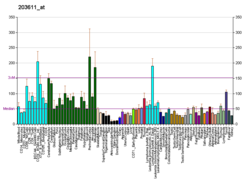- TERF2
-
TERF2

Protein Data Bank Identificadores Símbolos TERF2; TRBF2; TRF2 IDs Externas OMIM: 602027 MGI: 1195972 HomoloGene: 4133 Ontología Génica Función molecular: *Unión a ADN
*Unión a proteínas
*Unión a ADN telomérico de cadena sencillaComponente celular: *Cromosoma, telómero
*Núcleo
*CromosomaProceso biológico: *Mantenimiento del telómero vía telomerasa
*Ciclo celular
*Regulación de la transcripciónPatrón de expresión de ARN Ortólogos El factor de unión a repeticiones teloméricas 2, cuyo símbolo es TERF2 por sus siglas en inglés es un gen humano.
Este gen codifica una proteína específica de telómeros, Terf2, que es un componente del complejo de nucleoproteína telomérico, también conocido como telosoma. Esta proteína está presente en los telómeros en la metafase del ciclo celular, es un segundo regulador negativo de la longitud del telómero y desempeña un papel clave en la actividad protectora de los telómeros. Terf2 tiene una actividad similar a Terf1 en cuanto a organización en dominios y en su actividad de unión al ADN, pero difiere de éste que posee un extremo N-terminal de tipo básico en lugar de ácido.[1]
Referencias
Bibliografía
- Bilaud T, Koering CE, Binet-Brasselet E, et al. (1996). «The telobox, a Myb-related telomeric DNA binding motif found in proteins from yeast, plants and human.». Nucleic Acids Res. 24 (7): pp. 1294–303. PMID 8614633.
- Broccoli D, Smogorzewska A, Chong L, de Lange T (1997). «Human telomeres contain two distinct Myb-related proteins, TRF1 and TRF2.». Nat. Genet. 17 (2): pp. 231–5. doi:. PMID 9326950.
- Bilaud T, Brun C, Ancelin K, et al. (1997). «Telomeric localization of TRF2, a novel human telobox protein.». Nat. Genet. 17 (2): pp. 236–9. doi:. PMID 9326951.
- van Steensel B, Smogorzewska A, de Lange T (1998). «TRF2 protects human telomeres from end-to-end fusions.». Cell 92 (3): pp. 401–13. PMID 9476899.
- Sakaguchi AY, Padalecki SS, Mattern V, et al. (1999). «Chromosomal sublocalization of the transcribed human telomere repeat binding factor 2 gene and comparative mapping in the mouse.». Somat. Cell Mol. Genet. 24 (3): pp. 157–63. PMID 10226653.
- Griffith JD, Comeau L, Rosenfield S, et al. (1999). «Mammalian telomeres end in a large duplex loop.». Cell 97 (4): pp. 503–14. PMID 10338214.
- Teichmann M, Wang Z, Martinez E, et al. (2000). «Human TATA-binding protein-related factor-2 (hTRF2) stably associates with hTFIIA in HeLa cells.». Proc. Natl. Acad. Sci. U.S.A. 96 (24): pp. 13720–5. PMID 10570139.
- Smogorzewska A, van Steensel B, Bianchi A, et al. (2000). «Control of human telomere length by TRF1 and TRF2.». Mol. Cell. Biol. 20 (5): pp. 1659–68. PMID 10669743.
- Li B, Oestreich S, de Lange T (2000). «Identification of human Rap1: implications for telomere evolution.». Cell 101 (5): pp. 471–83. PMID 10850490.
- Zhu XD, Küster B, Mann M, et al. (2000). «Cell-cycle-regulated association of RAD50/MRE11/NBS1 with TRF2 and human telomeres.». Nat. Genet. 25 (3): pp. 347–52. doi:. PMID 10888888.
- Song K, Jung D, Jung Y, et al. (2000). «Interaction of human Ku70 with TRF2.». FEBS Lett. 481 (1): pp. 81–5. PMID 10984620.
- Song K, Jung Y, Jung D, Lee I (2001). «Human Ku70 interacts with heterochromatin protein 1alpha.». J. Biol. Chem. 276 (11): pp. 8321–7. doi:. PMID 11112778.
- Fairall L, Chapman L, Moss H, et al. (2001). «Structure of the TRFH dimerization domain of the human telomeric proteins TRF1 and TRF2.». Mol. Cell 8 (2): pp. 351–61. PMID 11545737.
- Bailey SM, Cornforth MN, Kurimasa A, et al. (2001). «Strand-specific postreplicative processing of mammalian telomeres.». Science 293 (5539): pp. 2462–5. doi:. PMID 11577237.
- Karlseder J, Smogorzewska A, de Lange T (2002). «Senescence induced by altered telomere state, not telomere loss.». Science 295 (5564): pp. 2446–9. doi:. PMID 11923537.
- Mignon-Ravix C, Depetris D, Delobel B, et al. (2002). «A human interstitial telomere associates in vivo with specific TRF2 and TIN2 proteins.». Eur. J. Hum. Genet. 10 (2): pp. 107–12. doi:. PMID 11938440.
- Ancelin K, Brunori M, Bauwens S, et al. (2002). «Targeting assay to study the cis functions of human telomeric proteins: evidence for inhibition of telomerase by TRF1 and for activation of telomere degradation by TRF2.». Mol. Cell. Biol. 22 (10): pp. 3474–87. PMID 11971978.
- Opresko PL, von Kobbe C, Laine JP, et al. (2002). «Telomere-binding protein TRF2 binds to and stimulates the Werner and Bloom syndrome helicases.». J. Biol. Chem. 277 (43): pp. 41110–9. doi:. PMID 12181313.
- Chagnon P, Michaud J, Mitchell G, et al. (2003). «A missense mutation (R565W) in cirhin (FLJ14728) in North American Indian childhood cirrhosis.». Am. J. Hum. Genet. 71 (6): pp. 1443–9. PMID 12417987.
- Strausberg RL, Feingold EA, Grouse LH, et al. (2003). «Generation and initial analysis of more than 15,000 full-length human and mouse cDNA sequences.». Proc. Natl. Acad. Sci. U.S.A. 99 (26): pp. 16899–903. doi:. PMID 12477932.
Wikimedia foundation. 2010.

